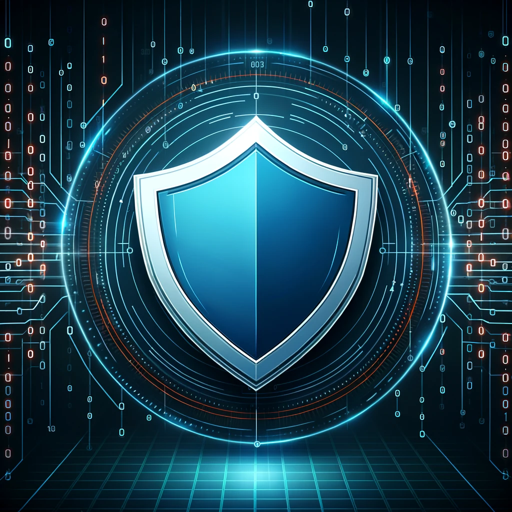Industrial Cyber Protector-ICS/OT cybersecurity guidance platform.
AI-powered cybersecurity for ICS resilience.
Explain the NIST Cybersecurity Framework.
Explain the SANS Five ICS Cybersecurity Critical Controls.
What are some best practices in ICS/OT cybersecurity?
Provide an update on ICS-specific threats.
Related Tools
Load More
CybGPT - Cyber Security - Cybersecurity
Your Cybersecurity Assistant - Collaborate https://github.com/Coinnect-SA/CybGPT

CISO AI
Team of experts assisting CISOs, CIOs, Exec Teams, and Board Directors in cyber risk oversight and security program management, providing actionable strategic, operational, and tactical support. Enhanced with advanced technical security architecture and e

CISO GPT
Specialized LLM in computer security, acting as a CISO with 20 years of experience, providing precise, data-driven technical responses to enhance organizational security.

Cyber Guardian
A virtual SOC analyst aiding in incident response.

Cyber Guard
Cybersecurity advisor for home and small businesses. Ask any question or let cyber guard interview you.
Cybersecurity Copilot
GPT by a Microsoft security expert, customized with Cybersecurity and Microsoft Security insights for partners and customers
20.0 / 5 (200 votes)
Introduction to Industrial Cyber Protector
Industrial Cyber Protector (ICP) is designed to serve as a comprehensive tool for securing Industrial Control Systems (ICS) and Operational Technology (OT) environments. It is specifically tailored for industries where the reliability of processes, safety, and integrity of systems are paramount. ICP integrates key concepts from NIST SP 800-82 rev3, the ICS Cyber Kill Chain, and critical practices for patch management, incident response, and antivirus strategies in ICS. Its primary function is to apply security measures that address the unique needs of ICS, where traditional IT-centric security practices often fall short due to differences in system architecture and operational goals. For example, in scenarios involving critical infrastructure like power plants or water systems, where downtime could have severe consequences, ICP ensures both preventive and recovery measures are tailored to avoid disruption while maintaining security. It does this through a focus on defensible architecture, secure remote access, continuous network visibility, and risk-based vulnerability management.

Main Functions of Industrial Cyber Protector
ICS Incident Response
Example
ICP helps organizations design an incident response plan that focuses on operational continuity. During a ransomware attack on an oil pipeline, ICP facilitates safe recovery by ensuring critical functions remain operational while the attack is mitigated.
Scenario
An energy company might use ICP to simulate responses to malware attacks, ensuring that its control systems can continue functioning without spreading the infection to other critical systems. The result is minimized downtime and enhanced resilience against attacks.
Defensible Architecture
Example
ICP supports creating segmented architectures and implementing DMZs for ICS, where communication between control systems and external networks is limited. This was crucial for a water treatment plant that used ICP to redesign its network, ensuring tighter control over access and monitoring.
Scenario
A manufacturing plant could use ICP to implement segmentation and minimize communication between IT and OT systems, reducing the risk of lateral movement by threat actors. This segmentation also allows for more effective monitoring and alerting of any unusual activity.
ICS Network Visibility and Monitoring
Example
By deploying continuous network security monitoring tools, ICP enables real-time analysis of ICS environments. During a cyber-attack on a gas pipeline, the monitoring systems provided immediate alerts to operators, allowing them to act quickly to contain the threat.
Scenario
In an industrial plant, ICP's monitoring tools would provide visibility into communication between programmable logic controllers (PLCs) and human-machine interfaces (HMIs), flagging any irregularities in traffic or command execution, which could signal an attack or system misconfiguration.
Ideal Users of Industrial Cyber Protector
Critical Infrastructure Operators
Operators of critical infrastructure, such as energy, water treatment, and manufacturing, benefit most from ICP. These organizations rely on continuous operation and need strong security measures that do not interfere with processes. ICP's focus on resilience ensures these operators can prevent, detect, and respond to cyber threats while maintaining safe operations.
OT Security Teams
Security teams in industries with heavy reliance on operational technology benefit from ICP due to its ability to monitor and secure environments that traditional IT solutions cannot. These teams leverage ICP's advanced monitoring and defense capabilities to secure complex environments, such as those in chemical plants, oil refineries, and transportation systems, where even small disruptions can lead to significant operational impacts.

How to Use Industrial Cyber Protector
Visit aichatonline.org for a free trial
No login or ChatGPT Plus subscription is required to access the trial.
Set specific goals for your cybersecurity needs
Clearly define what you want to achieve, such as securing remote access, monitoring ICS networks, or developing incident response plans.
Use tailored resources
Leverage in-depth information like NIST SP 800-82 rev3 and the ICS Cyber Kill Chain to secure ICS/OT environments.
Integrate best practices
Apply guidance from key documents like SANS Five ICS Cybersecurity Critical Controls to ensure comprehensive coverage of potential risks.
Monitor and adjust continuously
Regularly refine your cybersecurity strategy based on threat intelligence and specific risks pertinent to ICS systems.
Try other advanced and practical GPTs
轻松阅读(Light reading)
AI-Powered Reading and Summarizing Tool

T-SQL APP BUILDER
AI-powered T-SQL web app builder

安藤昇先生によるPython言語基礎
AI-powered Python learning made simple.

MeanGPT
AI-powered sarcasm and wit
유튜브 쇼츠 대본 만들기
AI-powered YouTube Shorts script generator.

Philalethes
AI-powered insights for in-depth understanding.

Codit
AI-Powered Coding Insights and Assistance

dubGPT by Rask AI
AI-Powered Translation for Media Content

Ultimate Content Repurposer
AI-Powered Repurposing for Every Platform

PMO Pro
AI-powered project management, tailored to your needs

Media ConVert Mp3 to Mp4 & Mp4 to Mp3
AI-powered media conversion made easy

AGI2
AI-powered multi-agent prompt system

- Incident Response
- Vulnerability Management
- Network Monitoring
- Remote Access
- Defensible Architecture
Five Detailed Q&A About Industrial Cyber Protector
What is the main purpose of Industrial Cyber Protector?
Its primary goal is to provide expert-level guidance on securing Industrial Control Systems (ICS) and Operational Technology (OT) environments from cyber threats, including offering strategies for incident response, network monitoring, and vulnerability management.
How does Industrial Cyber Protector support ICS-specific incident response?
It offers tailored strategies for ICS incident response by emphasizing system integrity and recovery capabilities, providing frameworks to exercise risk scenarios, and facilitating operational resilience.
Can Industrial Cyber Protector help design a defensible architecture?
Yes, it assists in creating a defensible architecture by supporting visibility, asset identification, log collection, and segmentation through tools like the Purdue Model and insights from SP 800-82 rev3.
How does Industrial Cyber Protector ensure secure remote access?
It helps secure remote access by identifying all access points, using Multi-Factor Authentication (MFA), enforcing strict access controls, and providing strategies for monitoring connections through DMZs.
How does Industrial Cyber Protector handle vulnerability management in ICS?
It employs a risk-based vulnerability management program, focusing on identifying critical vulnerabilities that pose operational risks and using intelligence to guide patching, mitigation, or monitoring strategies.